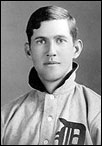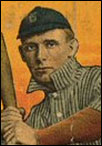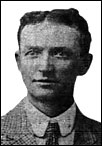It's the Mad Hatters !
With an incredible late-season run, the Medicine Hat Mad Hatters captured the pennant in the inaugural season of the Western Canada Baseball League
 Riding the arms of
Ralph Works (left) and George Hollis, the Hatters won 18 of their last 19 games (the other was a tie) to finish well ahead of the runner-up Edmonton Capitals. During the streak, Works, the right-hander, won eight times, Lefty Hollis registered six wins.
Works led all pitchers with 27 wins and was the leading hitter with a .341 average.
Riding the arms of
Ralph Works (left) and George Hollis, the Hatters won 18 of their last 19 games (the other was a tie) to finish well ahead of the runner-up Edmonton Capitals. During the streak, Works, the right-hander, won eight times, Lefty Hollis registered six wins.
Works led all pitchers with 27 wins and was the leading hitter with a .341 average.
In a post-season exhibition series, Medicine Hat and Winnipeg, champions of the Northern Copper Country League, split a pair of games at Winnipeg.
Western Canada's participation in organized ball goes back to 1907 when four Alberta clubs -- Edmonton Capitals/Legislators, Calgary Bronchos, Lethbridge Miners and Medicine Hat Hatters -- formed the Western Canada League.
The loop lasted just one season but returned in 1909 with eight teams, expanding to Saskatchewan with the Regina Bonepilers and Moose Jaw Robin Hoods and Manitoba for the Winnipeg Maroons and Brandon Angels.
This basic model continued for three summers, with Saskatoon replacing Medicine Hat in 1910 and Lethbridge and Regina dropping out in 1911.
Only a four-team Alberta league survived in 1912 before a resumption of the Western Canada circuit in 1913-1914.
The First World War put baseball on hold until 1919 when four franchises - Moose Jaw, Regina, Saskatoon and Winnipeg - competed. The Alberta teams, Calgary and Edmonton, were back in 1920 to make it a six-team loop. It last just two seasons.
1922 marked another attempt with the two Alberta clubs joining Vancouver and Tacoma, Washington, in the Western International League. It collapsed halfway through the season.
The Medicine Hat Mad Hatters captured the title in the inaugural season, finishing six games ahead of runner-up Edmonton.
The Hatters were led by future major leaguer Ralph Works who won 26 games (more below) and had the best batting mark, .341. Arthur O'Dea of Lethbridge was right behind Works with a .339 average. Former major leaguer Billy Hulen (playing under the name Billy Hamilton) scored the most runs, 95.
The early newspapers carried very few action photos, but used cartoon-like sketches to accompany game reports.
 |
 |
| GOUCHEE WAS HIT BY STERLING | SHORTY WATCHED IT PASS |
WESTERN CANADA BASEBALL LEAGUE
New Professional Baseball Organization is Launched
Medicine Hat, Alta., Oct. 15 -- Medicine Hat has caught the professional baseball fever. Regina also has a bad attack and from all accounts Moose Jaw, Lethbridge, Wetaskiwin and Red Deer are in danger of becoming infected with the same malady. Calgary and Edmonton are responsible fro the outbreak and this city and Regina seem to be especially hard hit judging from the enthusiasm which the delegates from the two aforesaid points showed at a meeting which was held in the hall today for the purpose of taking the preliminary steps in forming a professional league. The delegates present were : Calgary, W. J. Kirby, A. D. Fiddler, and B. L. Robinson, Edmonton, W. F. White; Regina, J. E. Youngrew,; Medicine Hat, Wm. Cousins, James Fleming, A. E. Whiffin, D. G. White, C. S. Pingle, Mayor Harris, and W. J. McLean.
The various details of organization were thoroughly discussed, the delegates being in session all day. it was decided to organize under the names of the Western Canada League of Professional ball clubs, and to join the National association. Calgary, Medicine Hat, Edmonton and Regina will receive franchises and two others will be issued either to Lethbridge and Moose Jaw or Wetaskiwin and Red Deer. A. D. Fiddler and W. J. Kirby were elected respectively provisional president and secretary.
A monthly salary limit of $1,200 was practically decided upon and the delegates meet again on Nov. 5 to complete organization, ec. The meeting was characterized by unbounded enthusiasm and confidence in the success which would attend the introduction of league professional ball in western Canada. [The Winnipeg Tribune, 16 October, 1906]
NEW ORGANIZATION IS FORMED IN ALBERTA
Four Club Circuit Composed of Lethbridge, Edmonton, Medicine Hat and Calgary Will Mark the Initial Season of the League--Baseball enthusiasm Running High In All Four Towns
LETHBRIDGE. Nov. 8 (1906) -- The Western Canada Baseball league was organized at Lethbridge on Tuesday with Medicine Hat, Calgary, Lethbridge and Edmonton as the circuit. At the organization meeting representatives were present from: Medicine Hat, Williams Cousins; Calgary, A. Fidler; Edmonton, Deacon White; Lethbridge, a score or more in all.
Enthusiasm is unbounded at Lethbridge and the league will be composed of the above mentioned cities. Such a circuit is undoubtedly the best available for a first venture in professional league baseball.
Lethbridge is able to raise some $4,000 to finance their club, which is amply sufficient, and really considerably more than will be needed. But it goes to show the spirit with which this new movement is being taken up; a spirit that is very typical of the west in everything that is attempted.
Calgary after manager
League baseball is all the talk at Calgary. The situation looks flattering for a compact, snug little circuit, composed of Medicine Hat, Lethbridge, Calgary and Edmonton. Calgary is already negotiating for players and the management is in communication with Sam LaRouke of the San Antonio South Texas league for playing manager. It will be necessary for Calgary to to buy his release, but they are sparing neither pains nor money here to get together the pennant winning team for next year's Western Canada Baseball league. Catcher Ford was presented with a diamond ring the other day by Calgary enthusiasts when they heard that Edmonton was trying to secure the star receiver.
Bill Hanrahan for Lethbridge
Medicine Hat is stirring up a cloud of dust in its efforts to get in a winning team. Jim Fleming of that city has undertaken to get the celebrated player, Bill Harris, in shape for next season by sending him to Winnipeg to take the Keely cure. Harris is a noted player of whom booze is getting the best of. Lethbridge is figuring on Bill Hanrahan for playing manager. he played left field for Winnipeg Maroons. (The Morning Telegram, Winnipeg, September 18, 1906, p.14)
The first graduate from the inaugural WCBL season, 1907, (and one of only three that initial campaign) to reach the major league level was 19 year old pitcher Ralph Works of the Medicine Hat Hatters (who had helped hone his talents pitching for a women's team in his home town, Des Moines in 1906).
Works fashioned a 27-9 won-lost mark pitching in 46 games (36 starts) for Medicine Hat. He led the circuit in strikeouts, with 217 (a total which stood throughout the brief history, to 1921, of the early Western Canada League), but also issued a record 129 bases on balls.
He made his big league pitching debut with the 1909 Detroit Tigers, compiling a 4 - 1 record in his rookie season which culminated in a brief two-inning relief stint facing the Pittsburgh Pirates in the World Series. He pitched a total of 5 seasons (1909 to 1913) in the majors with both the American League Tigers and the Cincinnati Reds of the National League. Works was tagged with the nickname "Judge" by his teammates for his scholarly countenance.

 Two players from the Lethbridge Miners advanced to the majors - Art Bues (left) with Boston and Chicago in the National League and Ed Kippert (right) with Cincinnati.
Two players from the Lethbridge Miners advanced to the majors - Art Bues (left) with Boston and Chicago in the National League and Ed Kippert (right) with Cincinnati.
Another former big leaguer, in Medicine Hat, playing under the name Billy Hamilton, turned out to be a missing person, thought dead.
Billy Hamilton was, in fact, former major league infielder, William F. "Billy" Hulen, who had gained attention as one of few left-handed shortstops in the game. Hulen had gone missing from his home and an extensive search had turned up no clues until notice came that he was playing ball in Canada.
'"The mystery as to the disappearance of Kid Hulen, who has played such a lot of good ball in the Northwest, is cleared up by reports from the Alberta country. He has been playing there with the Medicine Hat team this year. For a time Hulen was thought to be dead. His wife and mother worried themselves sick over his strange disappearance and even now it is not explained. Hulen finished the 1902 season with Seattle and captained the club the next year. In 1904 he managed the Everett team and won the pennant." (The Anaconda Standard, September 17, 1907)
 It appears Hulen (left) had, at one point, run a hotel in Winnipeg. "Billy Hamilton, a former proprietor of Noble's hotel, Winnipeg, who was with Medicine Hat last season, will captain the Spokane team. Hamilton is a former big leaguer, his diamond name being Billy Hulen. There was some talk of him getting the management of the Maroons before Eddie Herr landed the job." (Manitoba Free Press, March 25, 1908)
It appears Hulen (left) had, at one point, run a hotel in Winnipeg. "Billy Hamilton, a former proprietor of Noble's hotel, Winnipeg, who was with Medicine Hat last season, will captain the Spokane team. Hamilton is a former big leaguer, his diamond name being Billy Hulen. There was some talk of him getting the management of the Maroons before Eddie Herr landed the job." (Manitoba Free Press, March 25, 1908)
Married on March 7, 1896, Hulen disappeared February 20, 1906. He was working on a mining claim near Eureka, California, and left to travel to Seattle to raise funds to develop the mining operation. He was to stop and see his wife, Blanche, in Ashland, Oregon, along the way. He didn't. Given there was no hint of domestic trouble, a service organization, the Elks (of which Hulen was a member) began a search. They traced his luggage to Denver, but no further information was published. With the news he had been located in Canada, Blanche began divorce proceedings in March, 2007, citing desertion. No wonder he declined to use his real name in Canada.
 The job of manager in the new league was not for those hoping for long tenure. Calgary and Medicine Hat replaced their managers even before the first real pitch. A week and a half before the start of the regular schedule, Calgary dumped Frank P. Thyne and brought in former big leaguer William Henry Merritt (right) as manager. The team was organized in Lowell, Mass. and had began playing exhibition games on the way to Calgary. Merritt had been playing in the Lowell area.
The job of manager in the new league was not for those hoping for long tenure. Calgary and Medicine Hat replaced their managers even before the first real pitch. A week and a half before the start of the regular schedule, Calgary dumped Frank P. Thyne and brought in former big leaguer William Henry Merritt (right) as manager. The team was organized in Lowell, Mass. and had began playing exhibition games on the way to Calgary. Merritt had been playing in the Lowell area.
"Merritt does not think well of the Calgary bunch that was selected and it is understood that an entirely new bunch will be picked up, with the exception of O'Brien, the second baseman, and Farrell, the outfielder." (Manitoba Free Press, May 13, 1907)
Merritt, who had an eight-year major league career, from 1891 to 1899, would last only a month getting the pink slip June 17th, replaced by Alf Fidler.
Medicine Hat had been playing its way up to Alberta under manager George T. Nierstheimer who had previous experience at Jackson, Mississippi. However the club suffered a series of defeats in the exhibition games.
"The city was getting plenty of advertising as the press of the cities in which the games were played devoted lots of space to writing up the Canadian Gas City. This, however, was not the only object for which the team existed and active measures were taken last week to ascertain the cause of the trouble. From what could be ascertained from Mr. John Cousins, the team's financial agent, it seems that Manager Nierstheimer and the players were not pulling together, one of the principal causes of dissension being the manager's wish to play an infield position instead of his proper place on the left garden. A telegram from headquarters gave him his release. This method of getting at the root of affairs may have been drastic, but the step was taken on the advice of Mr. Cousins and that the team immediately took a brace is evident from the joyful news that the games in Keokuk and Burlington were both won -- the first by 4 to 1 and the next by 13 to 10. Quincy with its "C" class team which drawn a salary of $2900 a month or almost two and a half times as much as the Medicine Hat bunch was only able to win out by a score of three to nothing." (Medicine Hat News, May 09, 1907)
Catcher John Benny took over the team as manager. Benny had been playing-manager for Danville in the Virginia League the previous season.
In Lethbridge, John Morrison was the playing-manager with assistance from captain Arthur O'Dea.
Deacon White, who organized and promoted the Edmonton Grays, became an integral part of sports in the Alberta capital.
So, how did Medicine Hat, this relatively small community of 3-thousand, attract enough players for the inaugural season?
Catcher John Benny was one of the players recruited from Danville Red Sox. Benny, outfielders Gus Zurlage and Brownie McLain and pitcher Frank Ritchie had played with the Class C Virginia League team in 1906. Ritchie apparently also played in Canada in 1906.
Shortstop Red Perry had played with Paducah Indians of the Kentucky-Illinois-Tennessee League, a Class D club. Cy Young, a second baseman, had put in a few games in 1906 with Montgomery Senators of the Class A Southern Association. James Campbell and Lefty Hollis were reported to have come from a city league in Cincinnati. Outfielder Harry West, a Canadian, played for the team in St. Thomas, Ontario the previous season. Second baseman James Boylan was believed to have come from Helena, Montana. (The Newark. Ohio, Daily Advocate, April 18, 1907)
While the 1907 Western Canada Baseball League really was misnamed, being a four-team all-Alberta professional circuit, another pro league also had Western Canada representation in 1907, that being the Northern-Copper League within which the Winnipeg Maroons had a highly successful 1907 season, claiming the championship of that loop.
Unknown to many, however, was a presence of another professional club which operated on the prairies during the summer, but as an independent, non-affiliated club. Fred MacKinnon managed a group of skilled mercenaries brought in to represent Saskatoon on the diamond throughout Saskatchewan and while on tour of Manitoba, North Dakota and Minnesota. Prominent among the ringers were the Corrigan brothers, Jack, Joe and Frank. This group, literally, played in a number of money matches where it was winner take all. They ran roughshod over most of the wheat province opposition, thumping Regina 15 to 1 along the way. On June 27, they embarked upon a road trip of roughly five weeks which took them into Brandon, Winnipeg and a number of American towns and cities. Arriving back in the Hub City on August 4, their vagabond record was 13 wins, 6 losses and one tie. Included in their win total was a victory over the mighty Maroons, soon-to-be the toast of Winnipeg for their championship run.
Although the pro team was getting most of the attention in Saskatoon, the senior amateur level of ball was also doing well in 1907. A plethora of City League teams, ten in all, played regularly. The league opener on June 4 saw the Cairns Specials defeat the Shamrocks 15 to 13 as Francis and Goshell toed the rubber for the Merchant nine while Doane hurled for the Irish. Other teams in the league were the C.N.R., City Band, Clinkskill’s, Haultain, Real Estate, Currie Brothers, C.O.F and the Lacrosse Club.
Nowhere else in Saskatchewan was the level of participation and enthusiasm on par with that of Saskatoon. Although Regina did have a senior amateur team, no indication of the presence of an intra-city league in the Capital City ever appeared in the local newspaper. Moose Jaw, however, had a thriving four-team local circuit in 1907, headed by president W.E. Seaborn. The reigning champions, the Delphics, won the pennant again in 1907. Other teams in the Mill City league were the Athletics, Y.M.C.A. and South Hill. North of Saskatoon, a three-team league referred to as the Northern Saskatchewan League operated during the summer of 1907 with teams representing Prince Albert, Melfort and Birch Hills.
